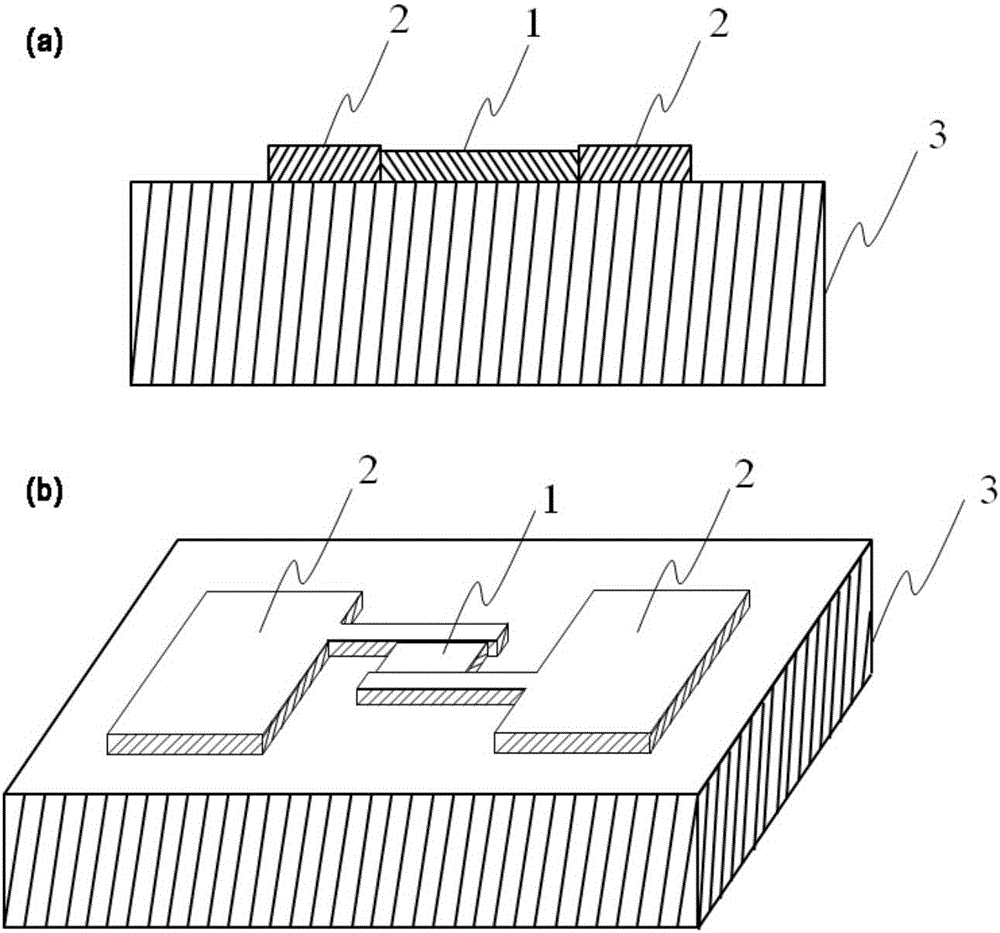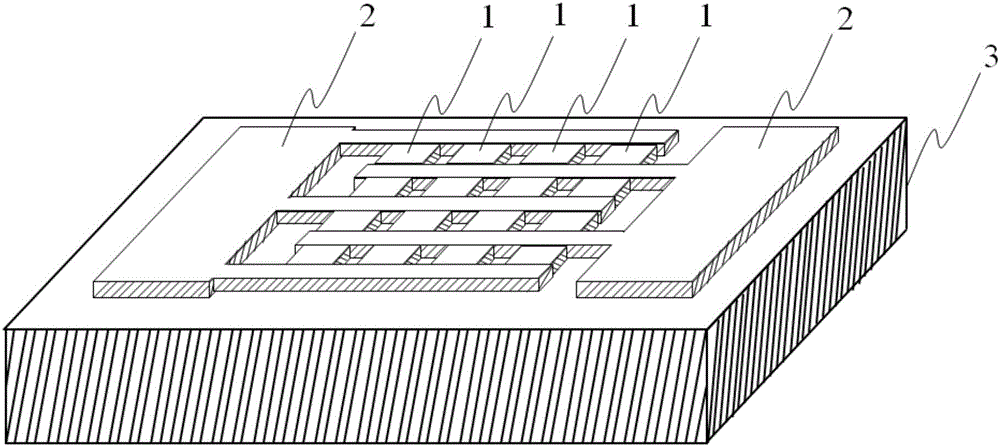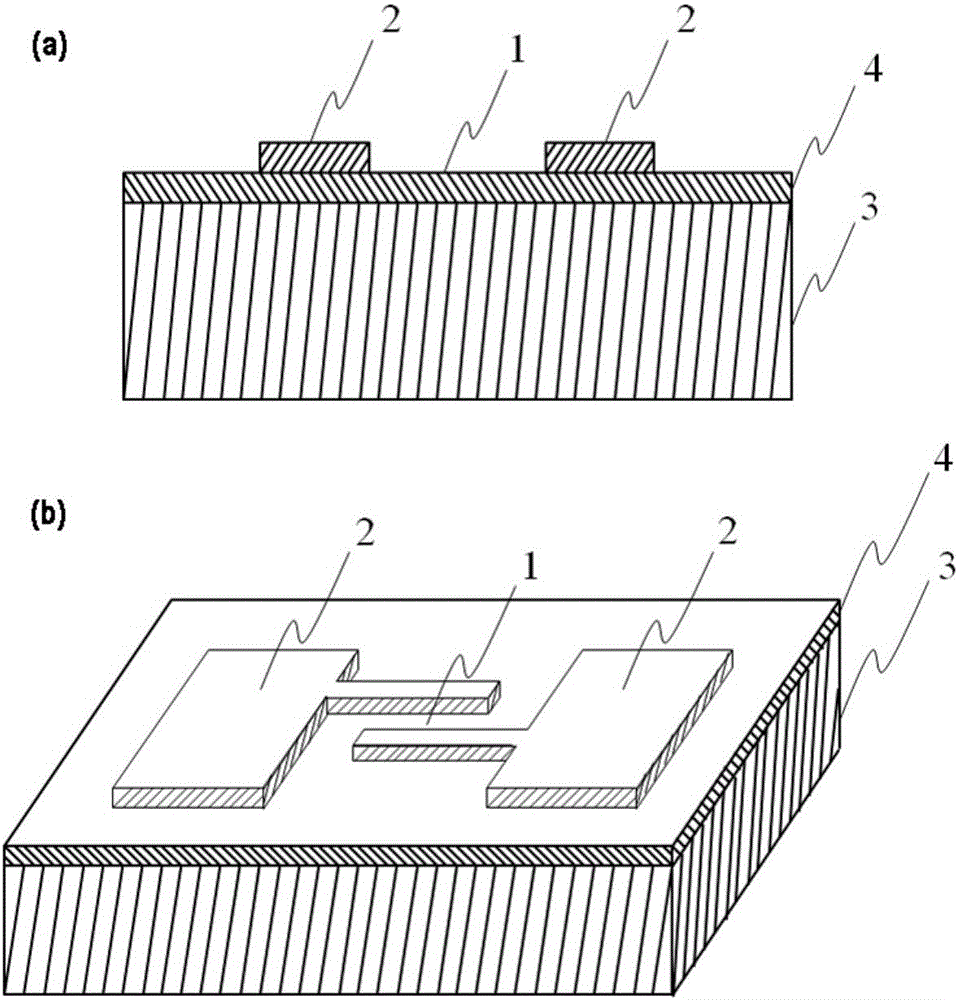Resistive material-based micro electron source and array thereof and implementation method
An implementation method and technology of electron source, applied in electronic science and field, can solve the problems of small emission current, low emission efficiency and high working voltage, and achieve the effects of low working voltage and temperature, good emission performance and convenient processing
- Summary
- Abstract
- Description
- Claims
- Application Information
AI Technical Summary
Problems solved by technology
Method used
Image
Examples
Embodiment 1
[0034] In this embodiment, the resistive material unit and the electrode pair are located at the same height as the substrate surface, and the resistive material unit is located between the electrode pair.
[0035] Such as figure 1 As shown, the micro-electron source constructed in this embodiment includes: a resistive material unit 1, an electrode pair 2 for activating the resistive material unit and driving its electron emission, and a lining for supporting the resistive material unit and the electrode pair. Bottom 3.
[0036] Such as figure 2 As shown, the micro-electron source array constructed in this embodiment includes: 4×4 figure 1 In the resistive material unit 1 of the miniature electron source shown, all the miniature electron sources are arranged on the same substrate 3 and connected in parallel through the interdigitated electrode pairs 2 .
[0037] The electrode pair in this embodiment includes two parts: the part directly connected with the resistive materia...
Embodiment 2
[0039]In this embodiment, the surface of the substrate is covered with a resistive material film, the electrode pairs are located above the resistive material film, and the resistive material film between the electrode pairs constitutes a resistive material unit
[0040] Such as image 3 As shown, the micro-electron source constructed in this embodiment includes: a support substrate 3, a resistive material film 4 covering the surface of the substrate, an electrode pair 2, and a resistive switch composed of a resistive material film between the electrode pairs 2. Materials Unit 1.
[0041] Such as Figure 4 As shown, the micro electron source array constructed in this embodiment includes: 2×4 image 3 In the resistive material unit 1 of the miniature electron source shown, all the miniature electron sources are arranged on the same substrate 3 and connected in parallel through the interdigitated electrode pairs 2 .
[0042] The electrode pair in this embodiment includes two ...
Embodiment 3
[0045] Next, using the method of micromachining, using palladium and titanium as electrodes, and silicon oxide as the resistive material, the micro-electron source in Example 2 is realized on the surface of the silicon substrate. The specific steps are as follows:
[0046] (1) Place the silicon wafer in a reaction tube made of quartz glass, heat the reaction tube to 900° C. and feed oxygen to oxidize the surface of the silicon wafer to obtain a 300 nm thick silicon oxide film.
[0047] (2) After spin-coating electron beam photoresist PMMA, electron beam exposure, developing and fixing, electron beam evaporation coating, stripping and other process steps, titanium palladium metal (0.5nm titanium / 70nm palladium) electrode pair, the minimum width of the prepared metal electrode is 220nm, and the electrode pair spacing is 50nm.
[0048] (3) Set one electrode of the above-prepared electrode pair to zero potential, and the other electrode to negative potential, gradually increase t...
PUM
 Login to View More
Login to View More Abstract
Description
Claims
Application Information
 Login to View More
Login to View More - R&D
- Intellectual Property
- Life Sciences
- Materials
- Tech Scout
- Unparalleled Data Quality
- Higher Quality Content
- 60% Fewer Hallucinations
Browse by: Latest US Patents, China's latest patents, Technical Efficacy Thesaurus, Application Domain, Technology Topic, Popular Technical Reports.
© 2025 PatSnap. All rights reserved.Legal|Privacy policy|Modern Slavery Act Transparency Statement|Sitemap|About US| Contact US: help@patsnap.com



